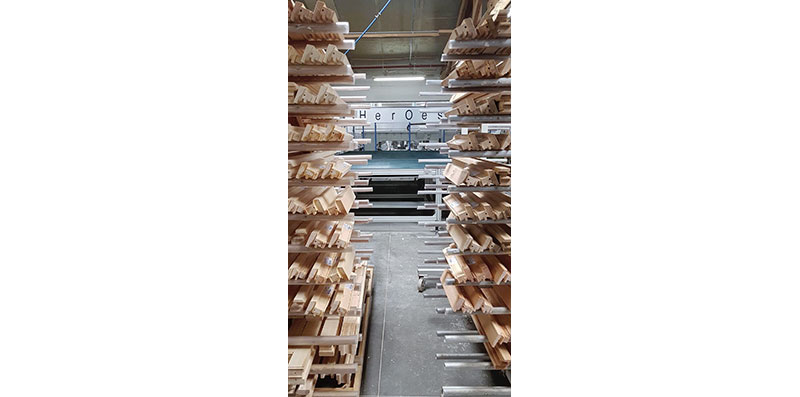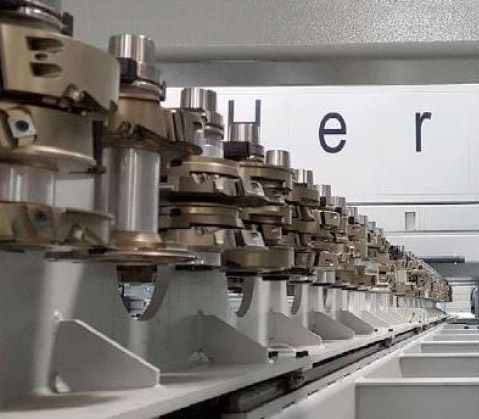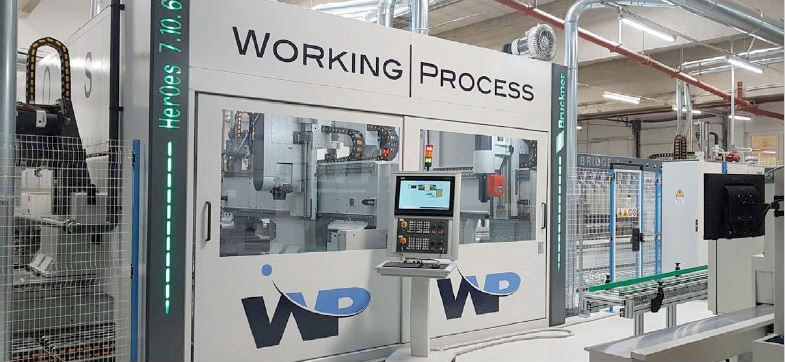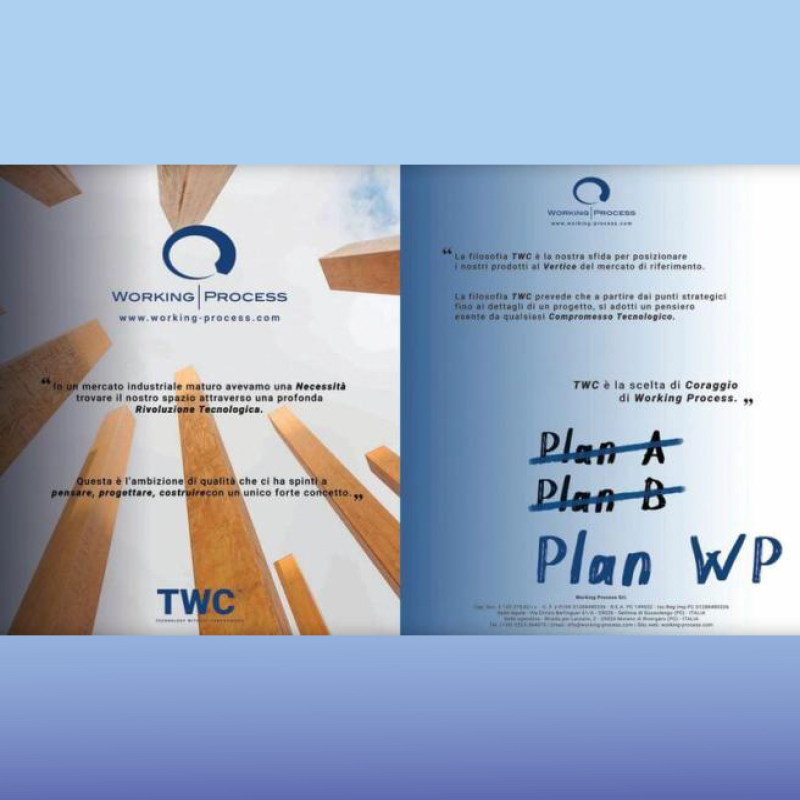For 20 years, when it was born, Working Process – specialized in technologies for the production of solid wood window and door frames – has been “silently” growing, measuring its steps, with the aim of distinguishing itself by target and defining its own identity. Today, a company that has made mechatronics its flagship, giving shape to industry 4.0, has implemented a corporate strategy that involves all the functional areas of the company to associate its brand with strong principles. Last September 15th we visited Working Process, where we met Stefano Schegginetti and Paolo Perservati, to discuss this specific topic: Corporate Identity.
In Working Process our working table involves the CFO and partner of the company Stefano Schegginetti and the Operation Manager Paolo Perservati, as well as Sonia Maritan who leads the meeting and Pietro Ferrari, editor of Web and Magazine. Once again this reality, now made up of around sixty employees, amazes for the clarity of the evolutionary plan that it has defined in terms of objectives and implementation times, for the determination of the high-end target to which it is aimed without compromise and for the objective of defining its identity through a Corporate strategy.
Faced with the economic crisis, the most structured companies have decided to implement their technologies – begins Stefano Schegginetti -. Today we are receiving requests from the most important companies in our woodworking sector for the production of windows and this is thanks to technology and line of high-end products that we offer and which they need today to more significantly reconvert their way of producing. The entrepreneurial world that knows how to deal with moments of crisis therefore invests and tries to restructure its production to restart the entire system that will allow it to exploit the high technology it has equipped with in the future. On the Working Process front we have not done nothing different, because this modus responds to our “natural” procedure: we have continued to believe in high technology and product quality, we have continued to aim for the development of a company that is growing internally by offering products that have a meaning on the market. This sees us strongly motivated towards an expansion to better manage our production areas, having increased the order book and having machines that now occupy several square meters within the production department with orders that are becoming increasingly “larger”. We are therefore planning a further expansion of 3,000 square meters in addition to the current 8,000, dedicated to the production part, which will involve the construction of a new warehouse, having 60,000 square meters of area currently owned by us available.
More orders and ever bigger orders! The acquisition of the property represents another novelty: when does it date back?<>. Paolo Perservati responds.<> .
From your point of view, how is Working Process evaluated today from “outside”?
Our company has positioned itself on the market as a manufacturer specialized in technologies for the construction of high quality wooden windows and doors, but we want to underline our external communication more importantly to be better known and recognized, in our medium size, for what we actually know how to do. Today we are following a line mainly linked to the identification of collaborators because it is essential to have good, trained and motivated collaborators, to count on people who have their ideas. Company know-how is made up of many elements, the first fundamental of which is understanding what the market wants and for this reason we have salespeople – both ours and agents or signalers – who move, are on the market and give us useful input to understand what the main trends are, but then within this idea of developing machines of a certain importance and technological capacity there is the person capable of creating them, this is human capital. Our know-how is in the hands of the people who ensure that everything that is created becomes knowledge management, that is, management of knowledge and availability of all news in an integrated system, such as the new ERP that we are implementing and will involve all functional areas of the company, an elaborate, advanced, modern and refined software system. So everything that will be designed and defined will remain within the company and all the knowledge that will be created will be stored in an IT brain that will allow us “tomorrow” to be able to request what we need in order to continue to expand the company’s evolution regardless of the employees who revolve around it. And we are proud to live in constant evolution, even if the problem for me, who takes care of the entire financial and strategic part within the company, is to understand when it is necessary to stop for a moment and exploit what has been identified and then put the products on the market, perhaps refine them slightly, but maintain the competitive advantage for as long as possible. And the heart of the matter is right here, because the risk of being “robbed” of the competitive advantage leads to the rush to want to change something to instill an antidote to the competitive advantage which at that point could be the prerogative of the competition. This can sometimes lead to making a change that is too sudden and instead the capable entrepreneur must have the sensitivity to understand when the time is right because this is what creates the real financial advantage. Therefore it is crucial to match the new idea with the ability to exploit it and bring it to fruition exactly and position it correctly on the market.

This is the objective of Working Process – adds Paolo Perservati – which intends to define its identity through a Corporate strategy that involves all the functional areas of the company, with the aim of creating a Corporate Identity to have a well-defined and be able to be recognized and stand out from your competitors. Working Process understands Corporate Identity as the perception that customers have of the company, how they see and perceive it. This is why it is so important for Working Process to build its own through a solid and reliable financial strategy, targeted communication and an impeccable coordinated image in order to be able to hit the right target and make all stakeholders perceive its value. In our opinion, the Corporate Identity contains the fundamental values and objectives of the brand, with the aim of transmitting the mission and ultimate vision of the two brands: WP and CML.
What should Corporate Identity be like for Working Process?
The Corporate Identity must be uniform, for the company’s identity to be strong, all the components involved must be in tune with each other and aimed at achieving the same final result, like the pieces of a puzzle. A strong identity must be recognisable, stand out from competitors and remain imprinted in the mind of the consumer who must be stimulated by transmitting our values in a direct and personal way. It is important to use language suitable for your target, textual and visual messages that affect their image and highlight our personality. The Corporate Identity must be familiar and positive, the brands (WP and CML) must convey positive values and inspire trust. With determination we want to share values with our stakeholders and earn their trust.
How does Working Process want to convey its Corporate Identity?
Working Process intends to convey its identity in three ways: with Corporate Finance, Corporate Marketing & Communication and Corporate Diligence. In the first case it is an advanced financial strategy, aimed at making targeted decisions on objectives defined with tools and related technical analyzes to identify the best balance between the sources available in the company and the uses to invest in, in order to achieve perfect management in the short/medium/long term both efficient (cost/benefit analysis) and effective (input/output analysis). It’s about pursuing growth objectives with absolute control of risks, as our partner and CFO has explained to us so far. Regarding corporate communication and its promotion, every promotional and advertising action serves the company to attract customers, respond to their needs and make the brands known. It is the visual transposition of company values. Everything that concerns the visual image of a company almost always goes hand in hand with branding and is the first impact on consumers who often recognize fonts, colors and graphic schemes. Providing a coordinated image is essential to stand out and be identified. Finally, regarding Corporate Diligence, it should be underlined that before promoting itself, a company must think about involving, sharing and transmitting values and ideas not only externally but also internally. A corporate sustainability program with a focus on human capital and territory is crucial in this sense. Communication today goes far beyond the simple presentation of a product, you need to know how to convey human values and experiences, and associate your brand with strong principles.

Stefano Schegginetti further enhances the concepts expressed by the Working Process OM, specifying the strategies that the company is adopting.
In short, we have explained a little about the fact that we gradually want to have the possibility of making people perceive who we actually are. Communication through the sustainability report, i.e. how the company creates its impact on society, also represents an important aspect of the portrait of our reality, because the stakeholders are none other than all those actively involved in this economic initiative. Among other things, we are a virtuous company because we do not consume energy by working in assembly and therefore with zero emissions, and we are a company that is paying very careful attention to the well-being of employees because we have understood that an employee must be well as well as physically also intellectually. It is already a company with a well-organised, clean production department – almost pharmaceutical convocations – and which guarantees a peaceful atmosphere, but we want to make it even more welcoming because for us it is important to create the healthiest environment possible. However, companies today must first of all be solid. In Anglo-Saxon “cash oriented” style, it is therefore essential to produce wealth to put the solidity that allows for continuous growth to come first, because it is also possible to make billions in turnover and produce losses. In our small way, we try to “grow with big ideas” and this is stimulating because we are confronted with a world that teaches that to move you need to have rules! However, today, the most important thing is the capital consistency, which fortunately we have, we are very liquid at the moment thanks to a very important policy that we are implementing which uses everything that credit can give us to help. Today, first of all, we carry out external communication towards the banking world very effectively because we have internal interlocutors, our employees, who speak the same language as the banking world, furthermore we have strong credibility because we have a very prosperous situation financially, from prime company. Finally, we are able to have, with the banking interface, the essential financing lines for large operations therefore targeted on specific projects. It is very important to be able to counter-guarantee a payment with a counter-guarantee created ad hoc, outside of the credit lines already granted. For example, recently for a very important client, in the process of approving an investment of 3 and a half million, which required in return to guarantee the down payment, to guarantee advance payments, to ensure our regular payment of suppliers, we have opened an ad hoc financing line. On the other hand, in the Covid 19 period, we paid our suppliers on time, joined the national campaign “I pay the suppliers” and did not ask for a moratorium on mortgages because these are actions that influence the corporate image which is also transmitted externally. whether there would be justification linked to contingency. The entrepreneur must take charge of the problems, he cannot turn them onto others: I have built my belief on this point.
This also means having created a solid communication with the stakeholders who perceive us most in everyday life, based on concreteness and above all punctuality, for example respect for a guarantee collected and paid off on the established date or a deposit paid on the fixed day. Of course, we can always do better and today we have the means with the latest generation marketing thanks to which we receive requests that we would never have been able to intercept, but this aspect can be explained better by our OM Paolo Perservati who together with my son Filippo Schegginetti follows this area>>. <<It is clear that we have moved from what was traditional marketing to digital marketing strongly aimed at the web – continues Paolo Perservati – it is a very broad project, it is not to be understood as the classic action linked to the product, but above all the first the objective is to make people perceive the company’s values and its contents. It is clear that this communication must be done solely with digital strategies, therefore also limiting areas of action, addressing a well-defined target of customers who are interested in specific contents, but not only linked to machines – of which we by choice we speak little – because a manufacturer of wooden windows is strongly interested in hearing about wood, the systems used to produce a window, the types of windows, the technology that allows them to be made, following the principle of Ludwig Mies van der Rohe who with the well-known quote “less is more” promoted an architecture that no longer looked at the pomp and complexity of the result as its objective. Our growth is targeted and gradual, and we are also doing the same thing with regards to marketing, in fact we have realized that there have been moments in which perhaps we have pushed too hard on the accelerator, also risking creating an imbalance in the company. Instead, within Working Process this widespread philosophy must be shared and made its own by everyone to reap the individual benefit that can be had for themselves but also for the company. We are hiring at the moment with a precise and targeted objective, not with a quantitative but a qualitative perspective. Usually a mistake that is made in periods of great growth is to hire by force, while we have rejected hires who probably had good professional profiles but who did not convey that feeling that is fundamental to our philosophy. The big difficulty is obviously in identifying the right skills which must be very high – we are certainly looking for young figures among the operators, such as the two mechanical engineers just hired in the mechanical technical office and the two IT engineers in the software/automation office, but we put the person first. It is a much broader project that must also go hand in hand with the product, because behind everything there is always the product notification which attests to the goodness of the thought. And we are evolving with new solutions on this front too. Aside from what is part of our DNA such as reliability and productivity, we are also starting a digitalisation journey on the product. We consider our machines to be high-performance if we look at the mechanical part and therefore it is on the aspect of the HMI (Human Machine Interface), i.e. the man-machine interface, or the function, the component of a specific device or software application that allows man to operate and interact with the machines we are now pouring our energies into. For our systems, wanting to distinguish ourselves from our competitors, however, we will not adopt a standard 4.0 package provided by third-party companies but we will do something modeled on our philosophy: it is a choice of coherence with respect to our choices, but also of independence, which allows everyone to connect as freely as possible. The fundamental project is to facilitate the machine’s interface with its universe through our software that will connect to any world; the aim is to give the mechanical part the possibility, as for the human body, to be used in all ways, that is, to create work environments in which the mechanics are free to be created according to the will of the user.
Our mechanical designer, our software developer today thinks of solutions and designs them, then conveying them into a software-electronic area, and when the machine is produced he checks them on it. We are thinking of simulators that reproduce the real movements of the system, of something like Virtual Commissioning, something which, in addition to giving us a benefit in the design and construction phase, could one day become a huge benefit for the customer too, because then we will to transport this type of technology onto the machine and therefore the customer, when he wants to think of a new solution, will no longer have to invent, program and develop it on the machine, but will already be able to see beforehand, through realistic simulations, the productivity, the cadence and the final yield, as if it were a BIM (Building Information Modeling) applied to the machine. In reality, we are already able to understand the language of every software house, but we want to do more.

Another ongoing project, therefore, is represented by an important implementation for the software part: dedicated to a fleet of machines that offers a complete range?
Today we are at an identification of the product range which we have almost completed – continues Stefano Schegginetti – from our smallest machine to the large lines which also lead to investments of 5/7 million Euros. We have two distinct departments that deal with our two brands: WP for the more flexible work centers and CML for the large, highly productive lines – mainly intended for non-European markets – and two different business units. Currently, in a corporate organization the functions are liquid, they are no longer inserted into a closed rectangle (the single problem no longer exists): the managers of our two respective brands talk to each other and influence each other for the solutions they seek. We are putting this into practice precisely with the only acquisition we have made externally, the CML which we acquired in 2013, to also obtain the technological competence of the “lines”, having left the top managers of the CML within our company and the Board of Directors, with Diego Ramacci, but also his daughter Glenda who is a lawyer and represents the legal office for us, while his son Matteo Ramacci is responsible for coordinating the progressive activities of orders and special projects. All this with compaction operations that must always be followed very carefully. Our vision is based on a company designed “big”. We are now finishing the general adoption of the new ERP – acronym for Enterprise Resource Planning, a management software that integrates all the relevant business processes of a company and all the company functions: administration, commercial, service/after sales, purchasing, production, logistics, finance, technical areas, human resources -, so that from January 1st 2021, according to the objective we have set ourselves, everyone has access to and uses a single information system with great benefits that will allow us to draw on precise data and unique. The next step will be the adoption of all the Risk Management rules according to the <> ex Legislative Decree 231/2001, precisely applying the principles of the largest companies, so as to allow us to be identified at the same way regarding the organizational aspect, although the turnover remains different. The short-term objective will be the introduction of a profound Risk Management model and an application of what will be the sustainability balance sheet, to achieve certification of the balance sheet drawn up by a company in a reasonable period of time, through correct and certified communication. internationally recognized external audit firm.
Finally, Pietro Ferrari brings the discussion on the representativeness of the company also to a trade fair level, considering the multitude of events canceled during the year and others partially reorganized in digital version or as open houses.
This reflection was also made out of necessity – continues Paolo Perservati -, because at the Nuremberg fair we had a stand already set up but then, as for Xylexpo in Milan, the event was cancelled. By now we are already talking about Hannover, which is still on the table, while it would be tiring to organize any open house due to the nature of our machines because 3, 4, or even 5 systems would be on display but all at different stages of progress and they are not finished machines which you can see in operation. Of course, we could transmit content with seminars or workshops. The idea is not to do something massive, also because we produce 15 to 20 systems a year and therefore we cannot organize a large-scale event because we would have limited appeal. Instead, we are thinking of organizing “All WP for You” meetings, that is, creating a format with very technical and very detailed basic contents. For example, holding a seminar talking about Industry 4.0 or artificial intelligence would be too generic for us, so it will be a matter of formulating an invitation proposal to targeted customers and making the company available for one or two days for the specific customer, also because it is important to be able to give them all the most in-depth information possible. The edition of Ligna in Hannover next year still represents a concern today because we would not want to allocate a customer’s machine for that fair, prepare a stand, with the risk of the event declining. So the idea is to think about a contained format, without a machine, and we would like to be present, instead of with the machine manufacturers, in the exhibition areas where there are systems engineers, designers, producers of hardware, glass, tools, etc. it would be new because no one has done it so far. This would avoid us talking about machines in a multi-target world and directing attention to topics related to the window by focusing on more specialized, more in-depth and more detailed contents, because in a generalist fair (like Milan or Hannover) we could talk about our machines at 2% of customers (in Nuremberg the percentage rises to around 10% because it is more sector-specific). On the other hand, the “reflection rocking” was also planned for the fair in Nuremberg in a corner of the stand, to invite the customer to sit down and dedicate “all” of his time to listening and thus send him the message of a shared project . This direction, essential for us, expresses true dedication to the customer and is expressed in many ways. With the same spirit we would like to create an area within the production for the customer that can be used for commercial purposes to touch upon the issues related to the window production process “within our creative workshop”. Just last week Filippo Schegginetti stayed for a week with one of our clients with a professional videomaker to create a very high quality video, because we are also updating the site which we want to be much more interactive towards the user, but also towards those who work with Working Process , therefore agents, resellers and customers. An opening that will allow the potential customer who has seen a case history of a company that uses one of our systems to register to be authorized to contact that company directly and be told what the system allows them to do.
by Sonia Maritan
Furnishing System, number 29

